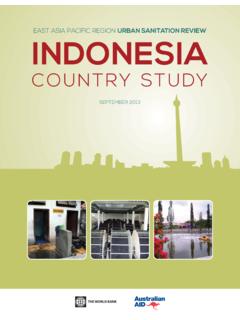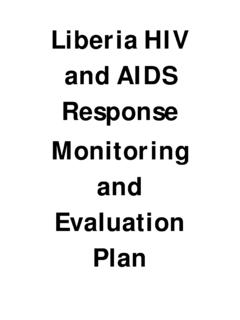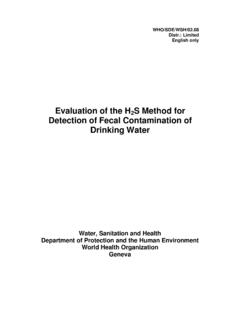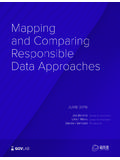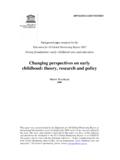Transcription of What makes a school a learning organisation? - OECD.org
1 What makes a school a learning organisation ?A guide for policy makers, school leaders and teachers Policy Advice and Implementation SupportINTRODUCTIONThis work is published under the responsibility of the Secretary-General of the OECD. The opinions expressed and arguments employed herein do not necessarily reflect the official views of OECD member document and any map included herein are without prejudice to the status of or sovereignty over any territory, to the delimitation of international frontiers and boundaries and to the name of any territory, city or can copy, download or print OECD content for your own use, and you can include excerpts from OECD publications, databases and multimedia products in your own documents, presentations, blogs, websites and teaching materials, provided that suitable acknowledgement of OECD as source and copyright owner is given.
2 All requests for public or commercial use and translation rights should be submitted to OECD 2016 WHAT ARE learning ORGANISATIONS?The concept of the learning organisation began to gain popularity in the late 1980s. While the literature is disparate, it is generally agreed that the learning organisation is a necessity, is suitable for any organisation and that an organisation s learning capability will be the only sustainable competitive advantage in the future. Most scholars see the learning organisation as a multi-level concept involving individual behaviour, team work, and organisation -wide practices and culture. A learning organisation is a place where the beliefs, values and norms of employees are brought to bear in support of sustained learning ; where a learning atmosphere , learning culture or learning climate is nurtured; and where learning to learn is essential for everyone involvedTHE NEED FOR A COMMON UNDERSTANDING OF THE school AS learning ORGANISATIOND espite strong support for and the intuitive appeal of the school as a learning organisation , relatively little progress has been made in advancing the concept, either in research or practice.
3 This lack of progress partly stems from a lack of clarity or common understanding of the school as learning organisation . Although reaching consensus is a daunting task, it can be achieved through further research and sustained dialogue among scholars, policy makers and educators around the world. The OECD- unicef Education Working Paper, What makes a school a learning organisation should be seen as a first step towards a shared understanding of the concept that is both based on the literature and is recognisable to all parties involved, scholars, educators, policy makers, students and parents. AIMS OF THIS BOOKLETThis booklet summarises some of the main findings published in the working paper. It is also intended to stimulate thinking and offer some practical guidance to school staff, (local) policy makers and other stakeholders who want to transform their schools into learning organisations.
4 Today s schools must equip students with the knowledge and skills they ll need to succeed in an uncertain, constantly changing tomorrow. But many schools look much the same today as they did a generation ago, and too many teachers are not developing the pedagogies and practices required to meet the diverse needs of 21st-century response, a growing body of scholars, educators and policy makers is making the case that schools should be reconceptualised as learning organisations that can react more quickly to changing external environments, embrace innovations in internal organisation , and ultimately improve student outcomes. Informed by a small network of experts, the OECD- unicef paper proposes an integrated school as learning organisation model that focuses on:l developing and sharing a vision centred on the learning of all studentsl creating and supporting continuous learning opportunities for all staffl promoting team learning and collaboration among all staffl establishing a culture of inquiry, innovation and explorationl embedding systems for collecting and exchanging knowledge and learningl learning with and from the external environment and larger learning system l modelling and growing learning leadership.
5 In short, a school as learning organisation has the capacity to change and adapt routinely to new environments and circumstances as its members, individually and together, learn their way to realising their vision. These seven action-oriented dimensions and their underlying characteristics, referred to as elements , highlight both what a school aspires to be and the processes it goes through as it transforms itself into a learning organisation . All seven dimensions are essential for this transformation to be sustainable; and in the end, the whole realising all seven dimensions will be greater than the sum of its parts. FOUR TRANSVERSAL THEMES: TRUST, TIME, TECHNOLOGY AND THINKING TOGETHER A set of themes flows through all seven dimensions: the four Ts: trust, time, technology and thinking together.
6 Although some of these themes may seem more pertinent to one action than to another, all four have an impact on the whole. For example, trust underpins the kind of relationships needed internally and externally for learning organisations to thrive; and all aspects of school development require the provision of integrated model of the school as learning organisationLOCALGOVERNMENTMINISTRYOF EDUCATIONHEALTH &OTHER SOCIALSERVICESHIGHEREDUCATIONINSTITUTION SCOMPANIESNGOsLOCALCOMMUNITYPARENTS &GUARDIANSSCHOOLNETWORKSCHOOLSCHOOLD eveloping and sharing a vision centred on the learning of all studentsModelling and growing learning leadershipSTUDENTLEARNINGL earning with and from the external environment and larger learning system Creating and supporting continuous learning opportunities for all sta Promoting team learning and collaboration among all sta Embedding systems for collecting and exchanging knowledge and learningEstablishing a culture of inquiry.
7 Innovation and explorationSCHOOL AS learning ORGANISATIONA school as a learning organisation has a shared vision that gives it a sense of direction and serves as a motivating force for sustained action to achieve individual and school goals. Having a shared vision is more an outcome of a process than it is a starting point a process that involves all staff, students, parents and other of the biggest challenges facing communities today is integrating those on the margins of society whose learning difficulties undermine their self-confidence. Not only is their exclusion a waste of human potential, their alienation poses a real threat to democracy. Education stakeholders need to believe that a school s vision and goals include a moral purpose.
8 Having an inspiring and motivating vision statement that is committed to enhancing the lives of all students is vitally important. Success in school is possible for all students. Many schools and education systems around the globe have realised their vision to dramatically improve the learning outcomes of the most disadvantaged children. PISA 2012, for example, shows that the countries that have improved student performance significantly since 2000, including Brazil, Germany, Greece, Italy, Mexico, Tunisia and Turkey, have managed to reduce the proportion of low-achieving students. The evidence shows that excellence and equity in education are not mutually exclusive , any vision to transform a school into a learning organisation should include two things: a front and centre commitment to making a difference in the learning and lives of all students, especially disadvantaged students; and a focus on learning and teaching that influences a broad range of outcomes both cognitive and social/emotional for today and the future.
9 Each individual must be equipped to seize learning opportunities throughout life, to broaden her or his knowledge, skills and attitudes, and to adapt to a changing, complex and interdependent : WHAT makes a school a learning organisation ?The actions needed to transform schools into learning organisations: an overviewl A shared and inclusive vision aims to enhance the learning experiences and outcomes of all studentsl The vision focuses on a broad range of learning outcomes, encompasses both the present and the future, and is inspiring and motivatingl learning and teaching are oriented towards realising the visionl Vision is the outcome of a process involving all staff l Students, parents, the external community and other partners are invited to contribute to the school s visionDEVELOPING A SHARED VISION CENTRED ON THE learning OF ALL STUDENTSThe kind of education needed today requires teachers who constantly advance their own professional knowledge and that of their profession.
10 A growing body of evidence shows that teachers professional development can have a positive impact on student performance and teachers practice. Consequently, scholars, educators and policy makers around the world increasingly support the notion of investing in quality, career-long opportunities for professional development, and ensuring ongoing, active professional learning . A school as a learning organisation has a supportive culture, and invests time and other resources in quality professional learning opportunities for all staff teachers, school leaders and support staff starting with their induction into the profession. It also connects work-based learning and external learning ( workshops or university courses), ensuring that the former is designed so that professional learning is sustainably embedded in daily practice.











